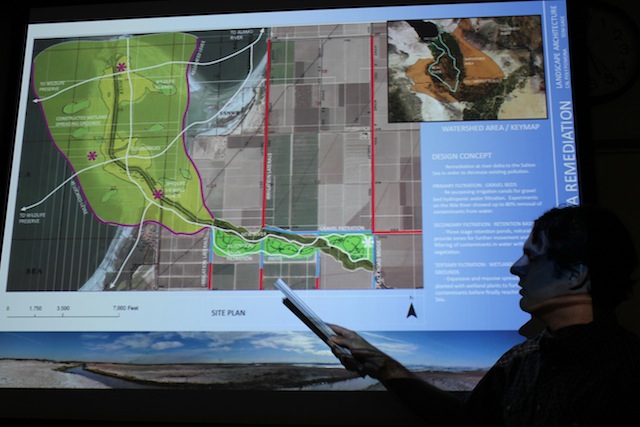High good, low bad: Mead in March 2012
Posted on | April 3, 2012 | 1 Comment

The steady rise of Lake Mead, clearinghouse of Colorado River water for the Southwestern US and Mexico, was heartening while it lasted. From a November 2010 low only seven feet shy of triggering shortage declarations, a steady flow into the biggest reservoir in the US throughout 2011 pushed Mead’s elevation 58 feet above the austerity line.
However, in March 2012, the level began to fall again. Look at year-on-year figures from the federal Bureau of Reclamation and it is clear that since 2000 the overwhelming trend has been downward. The entire river system, including Mead, is only 63% of what Reclamation classifies as full.
If there is good news to be had in decline, and there is, part of it is that an innovative landscape architecture instructor at Cal Poly Pomona is tweaking the founding Reclamation mission to “make the desert bloom.” Charged with leading a sustainability studio this winter, teacher Jessica Hall asked master’s degree candidates to “make the river the client.”  Last month, presentations by Hall’s class produced many good ideas and a couple of thrilling ones, not least the suggestion by student Tom Gage that relatively inexpensive gravel pits topped with pollution-filtering plants might be set in existing trenches to treat agricultural run-off into the Salton Sea. This amounts to conservation because he is using little more than rock, gravity flow, reeds and ingenuity to turn bad water into good water.
Last month, presentations by Hall’s class produced many good ideas and a couple of thrilling ones, not least the suggestion by student Tom Gage that relatively inexpensive gravel pits topped with pollution-filtering plants might be set in existing trenches to treat agricultural run-off into the Salton Sea. This amounts to conservation because he is using little more than rock, gravity flow, reeds and ingenuity to turn bad water into good water.
In a related presentation, fellow student Alex Fagnan proposed creation of salt ponds, reduction of the surface area and deepening of the Salton Sea as methods to reduce salinty and temperature so that the sea might continue to sustain birds on the Pacific flyway. Other presentations imagined:
* Putting landscaping where the river is by creating a variety of wildlife refuges, a fish hatchery and visitor centers along the banks
*Using the native vegetation to mitigate effects of farm run-off
* Using berms and vegetation to mitigate effects of mining pollution
* Switching water-hungry desert crops such as lettuce and alfalfa for tougher, more abstemious plants such as pomegranates and olives
* Covering of irrigation canals with solar panels to both generate energy and reduce evaporation
 Two presentations that arguably slipped the part of the brief stipulating that proposals concern the Lower Colorado still produced intriguing ideas, including a proposal for the re-landscaping of LA’s Pershing Square into a more sustainable, user-friendly format and dream-while-the-dreaming’s-good speculation of how Glen Canyon Dam might be de-comissioned while retaining its recreational value. To learn what inspired Hall to ask her class to take on river restoration as a landscaping goal, read her emerging Exploration of the Lower Colorado series at LA Creek Freak. In fact, read it anyway. Parts one and two serve as vivid reminders that water in Southern California doesn’t originate in the faucet, but wild watersheds worth saving and celebrating as we tap their resources. To see the presentations as posted by Hall, click here.
Two presentations that arguably slipped the part of the brief stipulating that proposals concern the Lower Colorado still produced intriguing ideas, including a proposal for the re-landscaping of LA’s Pershing Square into a more sustainable, user-friendly format and dream-while-the-dreaming’s-good speculation of how Glen Canyon Dam might be de-comissioned while retaining its recreational value. To learn what inspired Hall to ask her class to take on river restoration as a landscaping goal, read her emerging Exploration of the Lower Colorado series at LA Creek Freak. In fact, read it anyway. Parts one and two serve as vivid reminders that water in Southern California doesn’t originate in the faucet, but wild watersheds worth saving and celebrating as we tap their resources. To see the presentations as posted by Hall, click here.
Tags: chance of rain > Jessica Hall > LA Creek Freak > US Bureau of Reclamation
Comments
One Response to “High good, low bad: Mead in March 2012”
Leave a Reply



April 4th, 2012 @ 5:43 am
The fate of these big dams always makes me think of Edward Abbey… if he is somehow watching from beyond the grave, he must be laughing. The desert is reclaiming its slot canyons – not through flood or catastrophe or monkey wrench, but simply using two of the most powerful tools deserts have – dryness and time.
If the dams were managed simply to keep lakes intact, it might be possible to keep them mostly full (and lose even more water to evaporation) but as long as people need water from the Colorado (always as long as the West is populated) they will slowly get drier and drier.
If they ever are decommissioned I hope they are left in place in some form as reminders of the ridiculousness of the 20th century.